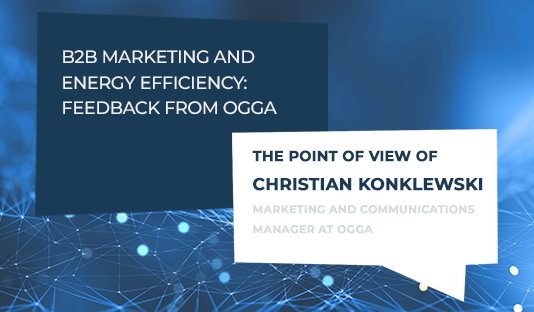The point of view of Christian Konklewski, our Marketing and Communications Manager.
What aspect of your job at OGGA challenges or inspires you the most?
What makes the most sense to me is contributing to the visibility of an energy efficiency solution that combines frugality and comfort for as many people as possible. Innovative thanks to its AI algorithms, this solution has been on the market since 2015. What’s more, working alongside experts in electronics, home automation and AI makes the experience even more stimulating.
On the technical side, OGGA often compares its Eco-Touch innovation to the Start & Stop system in cars. Just as an engine stops at a red light to save fuel, our solutions allow homes to adapt to the real needs of their occupants. They go into standby mode and reactivate automatically to ensure comfort at the right time. An approach that makes homes smarter and more energy efficient!
How do you manage to make technical subjects such as IoT or energy management accessible in a B2B communication strategy?
B2B customers have a high level of expertise, and they are our target audience. Rather than simplifying things, the challenge is to demonstrate an understanding of their challenges and realities. You have to be able to absorb their professional jargon like a sponge. The ideal approach is to pick up on their issues during casual conversations.
Then, listening to your colleagues is a gold mine:
- Engineers explaining a feature? That’s tomorrow’s customer argument.
- Customer service repeating the same explanation ten times a day? That’s the subject of your next post.
- Salespeople outlining the ideal acquisition of a lead? That’s the inspiration for your next infographic.
In your opinion, what are the major trends to watch in B2B marketing in 2025?
A report by Gartner reveals that B2B buyers are looking for the autonomy offered by digital technology, but need human reassurance.
This is precisely what we offer at OGGA: a hybrid strategy.
- Digital content (articles, benchmarks, video demos, configuration tools)
- Human added value during the scoping phase
The answer to the question “How does our solution solve your problem?” cannot be entirely digitised. We need to appeal to the reason of our interlocutors.
In a constantly evolving profession, how do you keep up to date with training and developments?
Developments happen in cycles. Right now, we are caught up in the media hype surrounding AI… for better or worse. Generative AI (LLM) is a recent and highly publicised subset, but it still remains a minority compared to traditional AI. Your professional circle is important.
Our efficiency calculations have included layers of AI since 2014.
Can you name a few books that have had a significant impact on you as a communicator?
“Mythologies” by Roland Barthes: a semiological analysis of French popular culture, revealing how certain objects become universal cultural and pop legends.
“No Logo” by Naomi Klein: this radical critique of the power of brands is based on an analysis of a system that goes beyond consumer goods to touch on the acquisition of identities and lifestyles.
“Communicator” by Thierry Libaert: a manual presenting eight fundamental techniques for building an internal and external communication strategy.
“Toute la fonction communication” by Assaël Adary, Thierry Libaert and Aude Riom: an operationally-oriented book covering the entire communications sphere, which is undergoing rapid change.
“The Art of Storytelling – Communication Manual” by Guillaume Lamarre: a practical guide exploring the fundamentals of storytelling applied to communication, with examples drawn from popular culture.
Finally, my current favourite: Jean Nouvel’s latest book, “Mes convictions” (Éditions Flammarion, 2025), is a manifesto for all communicators, as it goes beyond a simple autobiography to explore the art of conveying a vision. A visionary architect, Nouvel reveals how his intimate aesthetic convictions are transformed into powerful narratives capable of uniting teams and winning over decision-makers.
This book could be seen as a veritable lesson in communication. The architect demonstrates how even a radical idea can be convincing through the power of storytelling. His writing, sometimes provocative, reveals an attitude: ensuring that every word, like every line of his buildings, carries meaning.
His approach reminds us that communication is much more than just informing: it is about creating desire, engagement, and sometimes even the sublime. A book that also stands out for its elegance of spirit.
What advice would you give to a student who dreams of working in marketing and communications?
Be a sponge: cultivate your curiosity
Marketing is constantly evolving. Absorb everything around you: trends, innovations, behaviours. This curiosity will enable you to grasp developments.
Develop a solid general knowledge base
A broad cultural knowledge feeds your creativity and helps you make unexpected connections. Take an interest in art, history, psychology, science… This wealth of knowledge will give you a head start.
Master monitoring
Organise an effective monitoring system: specialised blogs, newsletters, social networks, webinars. Stay on top of trends and identify weak signals.
Become an expert in your areas of passion
While maintaining a broad perspective, develop specialised expertise in areas such as digital marketing, storytelling, data analysis, and brand strategy. This specialisation will set you apart.
Read extensively and write frequently
Reading enriches your vocabulary and nourishes your imagination. Writing structures your thinking and improves your communication skills. Practise both regularly.
Sharpen your critical thinking skills
In a world saturated with information, question statements, analyse sources and detect bias. This critical thinking will enable you to create more authentic campaigns.
Master generative AI
Learn to master prompting, understand the limitations and possibilities of these technologies to automate, create and optimise your content. Consider these tools as partners, while maintaining a critical eye on some of their claims. Apply a form of “beneficial doubt”, so to speak.
See you soon for another point of view!
